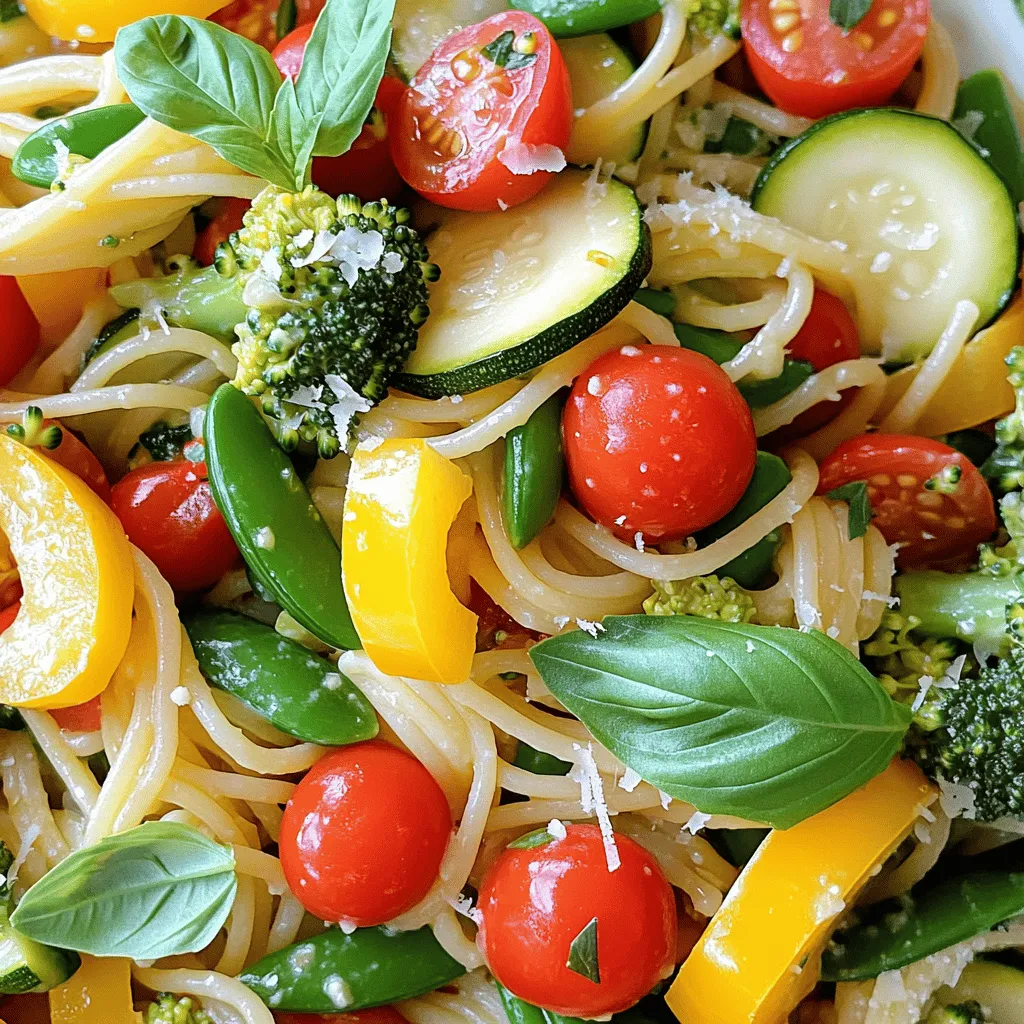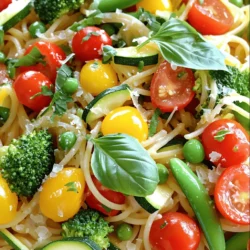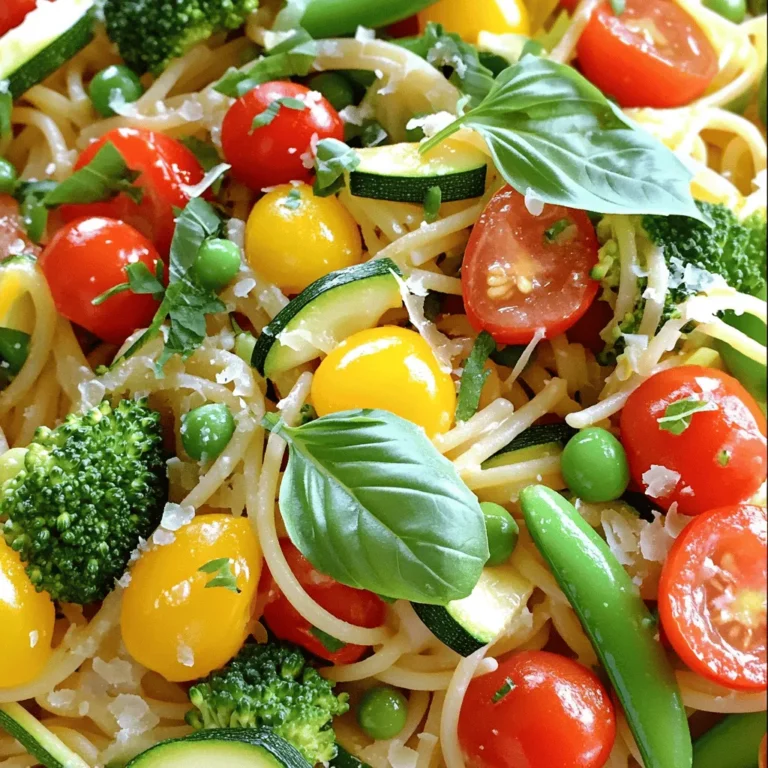Looking for a quick, tasty meal that’s also healthy? You’ve come to the right place! I’m excited to share my Easy Veggie Pasta Primavera recipe. Packed with fresh vegetables, this dish is colorful, delicious, and simple to make. Whether you’re a busy parent or just want a satisfying dinner, this recipe fits the bill. Let’s dive into how you can whip up this delightful meal in no time!
Ingredients
List of Ingredients
To make Easy Veggie Pasta Primavera, gather these fresh ingredients:
– 12 oz spaghetti or your preferred pasta
– 2 tablespoons extra virgin olive oil
– 1 medium zucchini, sliced into half-moons
– 1 cup mixed bell peppers (red, yellow, and green), sliced
– 1 cup cherry tomatoes, halved
– 1 cup broccoli florets, cut into bite-sized pieces
– 1 cup snap peas, trimmed and cleaned
– 3 cloves garlic, finely minced
– 1 teaspoon dried Italian herb blend (basil, oregano, thyme)
– Salt and freshly ground black pepper to taste
– ¼ cup freshly grated Parmesan cheese (optional)
– Fresh basil leaves, torn, for garnish
Best Pasta Options
When it comes to pasta, I recommend using spaghetti for this dish. It’s easy to cook and pairs well with veggies. Other great options include penne and fusilli. These shapes hold onto sauce and veggies nicely. You can also try whole grain or gluten-free pasta if you prefer. Just make sure to follow the cooking time on the package to get the right texture.
Fresh vs. Frozen Vegetables
Using fresh veggies makes the dish vibrant and full of flavor. They have a crunch that frozen ones often lack. However, frozen vegetables can save time. They are picked at their peak and flash-frozen. If you use frozen veggies, thaw them before cooking. This will help them cook evenly. For the best taste, I suggest sticking with fresh vegetables whenever you can.
Step-by-Step Instructions
Cooking the Pasta
Start by bringing a big pot of water to a boil. Add a good amount of salt to the water. This helps flavor the pasta. Next, add 12 oz of spaghetti or your favorite pasta. Cook it according to the package directions. You want it to be al dente, which means firm but not hard. Before you drain the pasta, save 1 cup of the water. This starchy water helps make the sauce creamy. After that, drain the pasta and set it aside.
Sautéing the Vegetables
In a large skillet, pour in 2 tablespoons of extra virgin olive oil. Heat it over medium heat. Once the oil is hot, add 3 cloves of minced garlic. Sauté the garlic for about 1 minute. It should smell nice but not burn. Now, add a medium zucchini, sliced into half-moons, and 1 cup of mixed bell peppers. You can use red, yellow, and green ones for color. Toss in 1 cup of broccoli florets and 1 cup of snap peas too. Cook everything together for 5-7 minutes. The veggies should look bright and be tender but still have a bit of crunch.
Combining All Ingredients
Now it’s time to bring it all together. Add 1 cup of halved cherry tomatoes to the skillet. Then, add the drained spaghetti along with the reserved pasta water. Gently mix everything together. Let it cook for another 2-3 minutes. This helps all the flavors blend. Next, sprinkle in 1 teaspoon of dried Italian herbs, along with salt and freshly ground black pepper. Toss it all again to make sure the seasoning is even. If you like, you can add ¼ cup of freshly grated Parmesan cheese to make it creamier. Finally, serve your dish hot, and top it with torn fresh basil leaves for extra flavor.
Tips & Tricks
Perfecting the Sauce
To create a great sauce, focus on the flavors. Start with quality extra virgin olive oil. Heat it gently in your skillet. Add minced garlic and watch for its aroma. This step is key to flavor. Mix in the dried Italian herbs next. The herbs add depth. If the sauce seems too dry, add some reserved pasta water. This water is starchy and helps bind the dish together.
Customization Options
Feel free to change up the veggies. Add or swap zucchini for asparagus or eggplant. Toss in spinach or kale for extra greens. You could also use seasonal veggies for freshness. Don’t forget about adding a splash of lemon juice for brightness. If you like spice, consider red pepper flakes. The goal is to make it your own!
Serving Suggestions and Presentation Tips
Serve your pasta in deep plates or bowls. This way, you show off the vibrant colors. A drizzle of olive oil adds a nice shine. Remember to top with fresh basil leaves, as they look and taste great. If you choose to add cheese, do it right before serving for a creamy touch. This makes your meal not only tasty but also visually appealing.

Variations
Vegan Alternatives
You can easily make this dish vegan. Simply skip the Parmesan cheese. Use nutritional yeast instead. It adds a cheesy flavor without dairy. You can also add more vegetables like carrots or spinach. This boosts the nutrition and color.
Gluten-Free Options
If you need a gluten-free meal, pick gluten-free pasta. Many brands offer great options made from rice or quinoa. Just follow the cooking time on the package. You can use the same veggies and flavors to keep it delicious.
Adding Proteins (Tofu, Chicken, etc.)
Want to add protein? Tofu is a great choice. Cut firm tofu into cubes and sauté it before adding veggies. If you prefer meat, grilled chicken works well too. Cook it separately, then mix it in with the veggies and pasta. This enhances the meal and makes it more filling.
Storage Info
Refrigeration Guidelines
After you make your pasta primavera, let it cool down. Place the leftover pasta in an airtight container. It will stay fresh in the fridge for about 3 to 5 days. Make sure to store it without extra sauce if you want to keep it from getting mushy.
Freezing Leftovers
You can freeze pasta primavera if you want to save it for later. Place it in a freezer-safe container. It can last up to 2 months in the freezer. To avoid freezer burn, wrap it tightly in plastic wrap or foil before sealing. When you’re ready to eat, just thaw it in the fridge overnight.
Reheating Tips
When it’s time to enjoy your leftover pasta, reheat it gently. You can use the microwave or a skillet. If using the microwave, cover it to keep moisture in. Heat for about 1-2 minutes, stirring halfway through. If using a skillet, add a splash of water to help steam it. Heat on low until warm. This helps keep the veggies nice and crisp. For the best flavor, consider adding a bit more olive oil or fresh herbs when reheating.
FAQs
How long does Veggie Pasta Primavera last in the fridge?
Veggie Pasta Primavera can last up to three days in the fridge. Store it in an airtight container. To keep it fresh, make sure it cools down before sealing.
Can I use other vegetables in this recipe?
Absolutely! You can swap in any veggies you like. Try carrots, asparagus, or spinach. Just make sure to adjust the cooking time for firmer vegetables.
What can I substitute for Parmesan cheese in a vegan version?
For a vegan option, use nutritional yeast. It adds a cheesy flavor without dairy. You could also use cashew cheese or a vegan Parmesan blend for a creamy touch.
How do I make this dish spicier?
To spice things up, add red pepper flakes or diced jalapeños. You can also toss in some hot sauce while cooking. Start with a small amount and adjust to your taste.
In this blog post, we explored how to make a delicious Veggie Pasta Primavera. We talked about key ingredients, like pasta and fresh veggies, and how to cook them step by step. I shared tips for perfecting your sauce and customizing your dish to fit your needs. We also covered variations, storage methods, and answers to your burning questions.
Now, you have the tools to create this tasty meal. Enjoy your cooking adventures!


